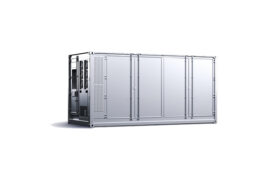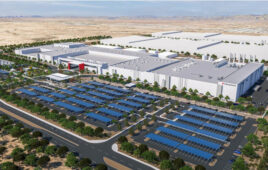Just as the United States is entering a solar panel manufacturing renaissance thanks to manufacturing tax credits included in the Inflation Reduction Act, the domestic battery-making industry should see a similar boost. Battery cells, modules/packs and electrode materials will all receive some type of credit when made domestically.
Thus far, primarily only major lithium battery makers in the EV space have announced new multi-gigawatt factories in the United States — Panasonic is building a 30-GWh facility in Kansas that will largely supply Tesla vehicles, and LG Energy Solution is working with Honda on a 40-GWh EV battery plant in Ohio. The country is still lacking significant production for the stationary energy storage market. There are some domestic manufacturers making small-scale lead- or lithium-based systems for mainly off-grid situations, but few major outfits have stepped up to provide much-needed support to a greening grid, until now.
KORE Power of Idaho is one of the first. The storage company was scheduled to break ground in December 2022 on a 12-GWh lithium battery factory in Buckeye, Arizona, that will supply battery cells to both EVs and energy storage systems. KORE has secured a U.S. supply of graphite anode materials (from Novonix out of Tennessee) that it will use in both its NMC and LFP battery cells made in America beginning in 2024.

Jay Bellows (RIGHT), president of KORE Power, with Gregg Nobel, VP of sales and development, in the Network Operations Center at KORE Solutions.
KORE Power was founded in 2018 and has U.S. intellectual property but currently makes its batteries through a Chinese contract manufacturer. Before IRA passage, KORE was already looking to set up domestic manufacturing to bring everything stateside. After acquiring Northern Reliability, a 50-year veteran in the energy storage commissioning space, in early 2022 and launching its own stationary energy storage installation division, KORE aims to be the only vertically integrated energy storage company in the United States — not only making products but also offering ESS installation services.
Solar Power World talked with Jay Bellows, president of KORE Power, about the company’s move into U.S. manufacturing and its outlook on the domestic market. This interview has been edited for clarity.
KORE Power was founded in 2018 as a “storage technology developer.” How would you describe the company now?
KORE Power is a manufacturer of battery cells and modules, both NMC and LFP — which is pretty rare. We have a lot of customers that want just batteries, and some want just cells to put in their own packets for EVs. We have a solutions group as well and offer complete systems through KORE Solutions. [Northern Reliability] has been building energy storage solutions for well over 50 years, and we’re probably the most experienced in the industry. With KORE Power, you ultimately get a vertically integrated solution, from soup to nuts, with arguably more market knowledge and experience than anyone else in the field.
Why was setting up battery manufacturing in the United States important to KORE, even before the IRA passed?
 There wasn’t really anybody else, quite frankly. And we have all these jobs disappearing in the fossil fuel industry, and it would be amazing to fill that with a more renewable mindset. The workforce for that is monstrous and taking advantage of that is a big deal. It’s a big goal of ours to bring everything home as much as we can, and we’re trying to do the same thing with the supply chain as well.
There wasn’t really anybody else, quite frankly. And we have all these jobs disappearing in the fossil fuel industry, and it would be amazing to fill that with a more renewable mindset. The workforce for that is monstrous and taking advantage of that is a big deal. It’s a big goal of ours to bring everything home as much as we can, and we’re trying to do the same thing with the supply chain as well.
Secondly, the ESS market and the EV market in the United States is growing exponentially. It’s a big deal to have that locally sourced as much as possible, for logistics and everything else. The cost of doing everything has gone up. When you include shipping and tariffs, it can be price-sensitive and restrictive for the industry. Bringing that here helps the industry grow substantially.
Here in the states, as we try to electrify our world, it’s going to be difficult for that to happen without storage. As we grow a renewable footprint with solar, wind, hydro, all of those things, we have to have a way to store that energy. It’s the perfect time to build out energy storage.
Why does KORE manufacture both NMC and LFP chemistries? Are the manufacturing methods significant to establish?
NMC has been around a long time. It’s one of the oldest lithium products. And then LFP came on identified as being a safer product — although NMC is also very safe at this point. For KORE doing them both, it really is about what the solution ultimately becomes. A lot of automobile manufacturers have built their chassis around different chemistries, so the goal is to be able to provide both.
I wouldn’t say [manufacturing NMC vs. LFP] is vastly different, but it’s different enough that each line has to be dedicated. The NMC line is larger than the LFP line.
How will the KOREPlex factory in Arizona be set up?
Right now, we’re in Phase 1 of our build, which will be done at the end of 2024. We’ll have two lines — one NMC and one LFP. It’ll be just over 3 GWh for each chemistry — 6 GWh total. Phase 2 will either be a direct replication of Phase 1 to get us to 12 GWh or we may just do LFP for the ESS market, so that would give us three lines of LFP.
How will the storage ITC and other installation incentives transform the U.S. storage market?
Storage already made financial sense. It already had a five- to seven-year return on investment. But now with the IRA, for a product that already made financial sense and was already identified as a key cog in bringing renewables [to the grid], it’s supercharged. It brings in a whole different level of customer for energy storage companies. Initially, large-scale customers were utilities and maybe some C&I. Now, it brings in every developer in energy. They get the same tax credit on top of everything else. The 30% ITC, the domestic product adder, the brownfield adder. When you’re an investor of a product that has a five-year ROI and now you’re getting a 50% tax credit? This is perfect timing for where the market was heading.
What will it take to make the United States an energy storage manufacturing powerhouse?
If the United States wants to become a leader, the focus has to be on consuming U.S. products. That may not be popular as the majority of our batteries come from Asia. If we want to be an industry leader, then we have to be committed to consuming localized product. I think we’re getting there. The IRA is a good step in that direction — with that 10% kicker for domestic product. We have to be committed to that, and it goes for both manufacturing and consuming.






“I wouldn’t say [manufacturing NMC vs. LFP] is vastly different, but it’s different enough that each line has to be dedicated. The NMC line is larger than the LFP line.”
This brings up (a) point that may ultimately be (the) point. Wet chemistries compared to dry battery cell chemistries like solid-state. Wet cells have one or more “drying stations” along the entire assembly line that needs specific engineering to keep volatile compounds from “pooling” in the manufacturing area and creating an explosive atmosphere. Solid-state battery chemistries usually don’t need the drying stations saving space, steps, energy and time to make each cell. The more cells per minute, hour, day of a manufacturing line, the cheaper they can be made. Getting battery packs down to $50/kWh would change the way people use energy storage in their daily lives. Bring it on!!!
If there is a way to get a silicon based nanowire anode material into the LFP battery chemistry this should improve the fast charge capability of the LFP chemistry. Companies like Innolith says they have an (Inorganic electrolyte) that is much less volatile than the current organic electrolytes used now in batteries. With engineered graphene cathodes one might find a chemistry for LFP that would double the gravimetric energy density of the LFP chemistry. That would put the LFP ahead of the NMC chemistry as a battery chemistry choice in the near future. For instance Australian company GMG is working on an aluminum graphene battery chemistry that has a “theoretical” gravimetric energy density of around 1,000Wh/kg and possible full charge/discharge cycling of around 3,000 cycles. 70% faster charge rate than standard LFP and much less temperature effect on the battery chemistry. Allowing one to use 90% cells in a battery pack by weight, increases the overall range of any BEV using the chemistry.